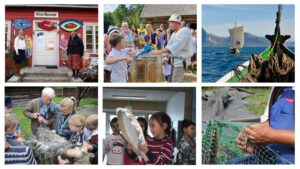
The main purpose of the website Safeguarding Practices is to share experiences in safeguarding intangible cultural heritage in the Nordic and Baltic region. Our vision is to generate synergies in wider and wider circles and facilitate processes of communication between different levels of stakeholders.
The Nordic and Baltic region is defined as Estonia, Lithuania, Latvia, Finland, Sweden, Norway, Denmark, Iceland as well as Greenland, the Faroe Islands and the Åland Islands.
The Convention, with its full name The UNESCOs 2003 Convention for the Safeguarding of the Intangible Cultural Heritage, is ratified by all state parties in the Nordic and Baltic region, but the process of implementation is at different stages in each country.
Rationales
Intangible cultural heritage is a complex phenomenon and concept.This regards the living heritage itself, but also the safeguarding processes and stakeholders which are a part of it. Working in the field, stakeholders experience constraints and obstacles many a times. This site offers stakeholders to look beyond their own practice and national borders, to be inspired or inspire.
Moreover, the idea is to::
- Bring to the fore innovative and creative practices
- Raise awareness of common identity as well as diversity in the region
- Join forces to harmonize the implementation of the Convention in the Nordic region
Stakeholders
The term stakeholders refers to non-governmental organizations (NGOs), grassroot groups, institutions and individuals in all areas of living heritage. They act either as practitioners or as coordinating organs and hubs with a mission to practice, pass on, transfer, train, research, document or raise awareness of living heritage.
A group of accredited NGOs plays a particular role regarding the Convention. They are accredited by UNESCO as experts in their field of intangible cultural heritage. Being accredited, requires a commitment to work in the spirit of the Convention.
Safeguarding
The Convention defines safeguarding strategies in the following way:
«… measures aimed at ensuring the viability of the intangible cultural heritage, including the identification, documentation, research, preservation, protection, promotion, enhancement, transmission, particularly through formal and non-formal education, as well as the revitalization of the various aspects of such heritage.»
The strategies may work one by one, or as a multiple in order to constitute a good practice
Good practices
Good practices are actions and activities in the shape of projects, programmes, measures, etc. which:
… demonstrate innovative, creative or effective approaches to safeguard intangible cultural heritage
… involves the participation of relevant stakeholders such as communities or practitioners
… is a way forward to identify/document/research; preserve/protect; promote/enhance; transmit; revitalize intangible cultural heritage.
… best reflect the principles and objectives of the UNESCO 2003 Convention (https://ich.unesco.org/en/convention#art2)
Contact information
The webpage is developed in collaboration with the Nordic and Baltic network on Intangible Cultural Heritage. The webpage has a broad advisory board, with representatives from both state parties, NGOs and communities.
For questions on the webpage, contact the editor:
Special Advisor mr. Einar Stamnes. Mail: einar.stamnes@handverksinstituttet.no
Norwegian Crafts Institute, Norsk håndverksinstitutt, Lillehammer, Norway (accredited NGO 2010)
